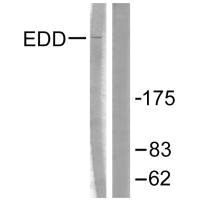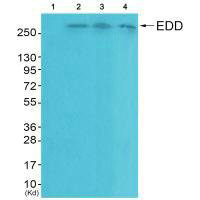-
货号:CSB-PA083120
-
规格:¥2024
-
图片:
-
Immunohistochemistry analysis of paraffin-embedded human breast carcinoma tissue using EDD antibody.
-
Western blot analysis of extracts from A549 cells, using EDD antibody.
-
Western blot analysis of extracts from HeLa cells (Lane 2), A549 cells (Lane 3) and HepG2 cells (Lane 4), using EDD antiobdy. The lane on the left is treated with systhesized peptide.
-
-
其他:
产品详情
-
产品名称:Rabbit anti-Homo sapiens (Human) UBR5 Polyclonal antibody
-
Uniprot No.:O95071
-
基因名:
-
宿主:Rabbit
-
反应种属:Human,Mouse
-
免疫原:Synthesized peptide derived from Internal of Human EDD.
-
免疫原种属:Homo sapiens (Human)
-
克隆类型:Polyclonal
-
纯化方式:The antibody was affinity-purified from rabbit antiserum by affinity-chromatography using epitope-specific immunogen.
-
浓度:It differs from different batches. Please contact us to confirm it.
-
产品提供形式:Liquid
-
应用范围:ELISA,WB,IHC
-
推荐稀释比:
Application Recommended Dilution WB 1:500-1:3000 IHC 1:50-1:100 -
Protocols:
-
储存条件:Upon receipt, store at -20°C or -80°C. Avoid repeated freeze.
-
货期:Basically, we can dispatch the products out in 1-3 working days after receiving your orders. Delivery time maybe differs from different purchasing way or location, please kindly consult your local distributors for specific delivery time.
引用文献
- E3 ubiquitin ligase UBR5 modulates circadian rhythm by facilitating the ubiquitination and degradation of the key clock transcription factor BMAL1 C Duan,Acta pharmacologica Sinica,2024
相关产品
靶点详情
-
功能:E3 ubiquitin-protein ligase which is a component of the N-end rule pathway. Recognizes and binds to proteins bearing specific N-terminal residues that are destabilizing according to the N-end rule, leading to their ubiquitination and subsequent degradation. Involved in maturation and/or transcriptional regulation of mRNA by activating CDK9 by polyubiquitination. May play a role in control of cell cycle progression. May have tumor suppressor function. Regulates DNA topoisomerase II binding protein (TopBP1) in the DNA damage response. Plays an essential role in extraembryonic development. Ubiquitinates acetylated PCK1. Also acts as a regulator of DNA damage response by acting as a suppressor of RNF168, an E3 ubiquitin-protein ligase that promotes accumulation of 'Lys-63'-linked histone H2A and H2AX at DNA damage sites, thereby acting as a guard against excessive spreading of ubiquitinated chromatin at damaged chromosomes.
-
基因功能参考文献:
- UBR5 is a modulator of super-vigilant proteostasis of induced pluripotent stem cells from Huntington's disease patients PMID: 30038412
- UBR5 was highly expressed in colon cancer not only at mRNA level but also at protein level; UBR5 promoted the growth of colon cancer cells, and inhibited apoptosis. PMID: 29441938
- BMI1 and UBR5 repress the polymerase II (Pol II)-mediated transcription at damaged sites PMID: 27647897
- Results found that EDD was consistent with GOLPH3 expression and also promoted the EMT process and activated Wnt/beta-catenin signaling in epithelial ovarian cancer. PMID: 28332316
- UBR5 directly binds to the tumor suppressor esophageal cancer-related gene 4, increasing its ubiquitination to reducing the protein stability of ECRG4 to promote colorectal cancer progression. PMID: 28856538
- Wnt-dependent inactivation of the Groucho/TLE co-repressor by the HECT E3 ubiquitin ligase Hyd/UBR5 is a key prerequisite that enables Armadillo/beta-catenin to activate transcription. PMID: 28689657
- UBR5 downregulates proapoptotic MOAP-1 and suggest that UBR5 can confer cisplatin resistance in ovarian cancer. PMID: 27721409
- Data suggest that UBR5 down-regulates levels of TRAF3, a key component of Toll-like receptor signaling, via the miRNA pathway; p90RSK is an upstream regulator of UBR5; p90RSK phosphorylates UBR5 as required for translational repression of TRAF3 mRNA. (UBR5 = ubiquitin protein ligase E3 component n-recognin 5 protein; TRAF3 = TNF receptor-associated factor 3; p90RSK = 90 kDa ribosomal protein S6 kinase) PMID: 28559278
- Data show that ubiquitin protein ligase E3 component n-recognin 5 protein (UBR5) bound the tumor suppressor gastrokine 1 (GKN1) and increased its ubiquitination to reduce the protein stability of GKN1. PMID: 27590582
- Findings unveil UBR5 as a novel and critical regulator of tumor growth, metastasis, and immune response in triple negative breast cancer. PMID: 28330927
- Study highlights many functional biological role of UBR5 especially in cancer where it seems to be a key regulator of cell signaling. [review] PMID: 26464214
- Human herpesvirus-6 U14 induces cell cycle arrest in G2/M phase by associating with a cellular protein, EDD. PMID: 26340541
- Elevated metaphase RanGTP levels use Ubr5 to couple overall chromosome congression to SAC silencing. PMID: 26438829
- results confirm the role of the MLLE domain of UBR5 in substrate recruitment and suggest a potential role in regulating UBR5 ligase activity. PMID: 26224628
- these observations highlight the potential role of EDD in regulating mitotic progression and the cellular response to perturbed mitosis. PMID: 25833949
- Utilizing a high throughput RNAi screening approach identified UBR5, a protein commonly amplified in breast cancer, as a novel regulator of ERalpha protein levels and transcriptional activity. PMID: 24441042
- the alpha4 N-terminus binding to endogenous PP2Ac and PABP, and the C-terminus to EDD, is reported. PMID: 24145130
- These results identify EDD as a dual regulator of cell survival and cisplatin resistance and suggest that EDD is a therapeutic target for ovarian cancer. PMID: 24379240
- UBR5 knockdown results in accumulation of cellular pregnane X receptor and an increase in its activity. PMID: 24438055
- As a molecular adaptor, Vpr enhanced the interaction between TERT and the VPRBP substrate receptor of the DYRK2-associated EDD-DDB1-VPRBP E3 ligase complex, resulting in increased ubiquitination of TERT. PMID: 23612978
- The recurrence and clustering of deleterious mutations implicate UBR5 mutations as a critical pathogenic event in a subgroup of mantle cell lymphoma. PMID: 23407552
- Data indicate that Dyrk2 phosphorylates TERT protein, which is then associated with the EDD-DDB1-VprBP E3 ligase complex for subsequent ubiquitin-mediated TERT protein degradation. PMID: 23362280
- Ubiquitination assays showed that the C-lobe of UBR5 is able to form a thioester-linked E3-ubiquitin complex, although it does not physically interact with UBCH4 in NMR experiments PMID: 23027739
- Study shows that TRIP12 and UBR5, two HECT domain ubiquitin E3 ligases, control accumulation of RNF168, a rate-limiting component of a pathway that ubiquitylates histones after DNA breakage. PMID: 22884692
- Increased p53 levels upon EDD depletion cause a G(1) arrest, as co-depletion of EDD and p53 completely rescues this effect on cell cycle progression. PMID: 22374670
- EDD1 suppresses death-receptor expression, and its expression is elevated in breast, pancreas, and lung cancer cell lines resistant to death receptor-mediated apoptosis. PMID: 21949371
- through binding to p53, EDD actively inhibits p53 phosphorylation by ATM and plays a role in ensuring smooth G(1)/S progression. PMID: 21383020
- EDD ubiquitinates beta-catenin through Lys29- or Lys11-linked ubiquitin chains, leading to enhanced stability of beta-catenin. PMID: 21118991
- The s show that human EDD can interact independently with both human papillomavirus type 18 E6 and human E6AP. PMID: 21228227
- identify UBR5 as a novel E3 ligase that regulates transcription and define an additional function of TFIIS in the regulation of CDK9. PMID: 21127351
- study confirmed the presence of UBR5 mutation in exon 45 in high microsatellite instability cacarcinomas; could not identify exon 42 mutations in colorectal cancers and exon 51 mutations in breast cancers PMID: 20025491
- ubiquitin-protein ligase EDD interacts with importin alpha 5 through consensus basic nuclear localization signals and is localized in cell nuclei. EDD also binds progesterone receptor (PR) and potentiates progestin-mediated gene transactivation. PMID: 12011095
- EDD is a novel mediator in DNA damage signal transduction via CHK2 and emphasize the potential importance of EDD in cancer. PMID: 17074762
- EDD plays the role in the maintenance of genomic stability, emphasising the potential importance of dysregulated EDD expression and/or function in the evolution of cancer. PMID: 18073532
- These results identify EDD as a new independent prognostic marker for outcome in serous ovarian cancer PMID: 18349819
显示更多
收起更多
-
亚细胞定位:Nucleus.
-
组织特异性:Widely expressed. Most abundant in testis and expressed at high levels in brain, pituitary and kidney.
-
数据库链接:
HGNC: 16806
OMIM: 608413
KEGG: hsa:51366
STRING: 9606.ENSP00000429084
UniGene: Hs.492445
Most popular with customers
-
YWHAB Recombinant Monoclonal Antibody
Applications: ELISA, WB, IF, FC
Species Reactivity: Human, Mouse, Rat
-
Phospho-YAP1 (S127) Recombinant Monoclonal Antibody
Applications: ELISA, WB, IHC
Species Reactivity: Human
-
-
-
-
-
-























